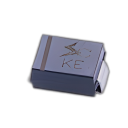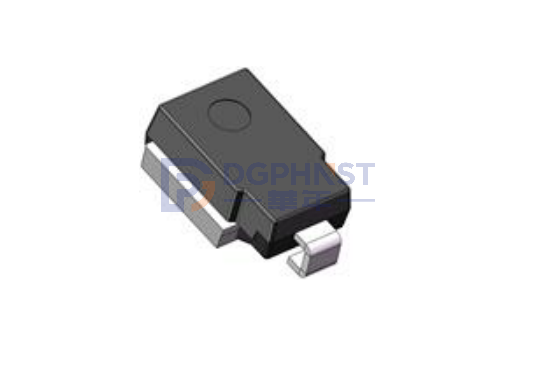Although there are differences in detailed parameters and application focus between TVS tubes (transient voltage suppressors) and ESD electrostatic protection tubes (electrostatic discharge protection devices), as core components in the field of circuit protection, the two exhibit high consistency in protection mechanisms, technical characteristics, and design logic. Analyze their commonalities from four dimensions:
1、 Core protection mechanism: Transient energy release based on PN junction
Both utilize the avalanche effect or Zener breakdown effect of semiconductor PN junctions to achieve transient overvoltage suppression:
Static high impedance state: Under normal operating voltage, both TVS and ESD tubes exhibit high impedance state, with extremely small leakage current (nanoampere level) and no interference to circuit function.
Dynamic conduction characteristics: When the voltage exceeds the breakdown threshold (VBR, usually defined as the voltage at 1mA current), the device quickly (in nanoseconds) switches from high resistance to low resistance, clamping the voltage at a safe level by conducting a large current to avoid damage to the subsequent circuit.
Self recovery capability: After the transient overvoltage disappears, the device automatically recovers to a high resistance state and can be reused.
2、 Application scenario overlap: focus on sensitive interfaces and chip level protection
Interface protection:
All used for electrostatic protection of high-speed interfaces such as USB, HDMI, Ethernet, etc., to prevent transient voltage introduced by plugging or external interference.
In power line and signal line protection, the two can be used interchangeably, but ESD tubes are more suitable for compact designs due to their smaller packaging (such as DFN, SOD-123).
Chip level protection:
Protect the I/O pins and power pins of MCU, memory, and other chips to prevent latch up effects caused by static electricity or surges.
In high-frequency signal lines such as RF antennas and high-speed data buses, low junction capacitance (<1pF) ESD tubes or TVS should be selected to reduce signal attenuation.
Industry universality:
The fields of consumer electronics (mobile phones, tablets), automotive electronics (ECU, sensors), industrial equipment (PLC, motor drives), etc. all require collaborative protection between the two.
3、 Key parameter synergy: balancing response speed and clamping capability
Breakdown voltage (VBR) and clamp voltage (VC):
VBR defines the threshold for device startup protection, while VC represents the maximum clamping voltage at a specific pulse current (IPP).
Both must meet the following requirements: VC<the withstand voltage value of the protected device, and VBR slightly higher than the maximum operating voltage of the circuit.
Peak Pulse Power (PPPM):
Determined by the product of IPP and VC, it reflects the device's ability to withstand transient energy.
TVS is commonly used for lightning and surge protection due to its higher power (several hundred watts to several kilowatts); ESD tubes focus on electrostatic protection (with lower power).
Junction capacitance (Cj) and leakage current (IR):
The junction capacitance affects signal integrity, and in high-frequency scenarios, ESD tubes or TVS with Cj<0.5pF should be selected.
The leakage current should be controlled at microampere level to avoid interference with low-power circuits (such as IoT devices).
4、 Unified Design Logic: Systematic Considerations from Standards to Selection
Standard compatibility:
All tests must pass international standards such as IEC 61000-4-2 (ESD), IEC 61000-4-4 (EFT), and IEC 61000-4-5 (surge).
For example, TVS tubes need to meet the 8/20 μ s surge waveform test, while ESD tubes need to pass ESD tests with contact discharge ± 8kV and air discharge ± 15kV.
Selection principle:
Voltage matching: VRMM (reverse cut-off voltage) should be slightly higher than the maximum operating voltage of the circuit to ensure that the device does not conduct during normal operation.
Power redundancy: Select sufficient PPPM according to the application scenario, such as PPPM>1500W for lightning protection and PPPM>300W for electrostatic protection.
Package optimization: Multi channel interfaces (such as USB Type-C) require array packaging (such as 4-channel ESD tubes) to reduce PCB footprint.
Conclusion: Complementary and Collaborative Circuit Protection System
TVS tube and ESD electrostatic protection tube are like "fuses" and "safety airbags" in circuits, with the former focusing on heavy energy surge protection and the latter on high-frequency electrostatic suppression. The commonality in principle (PN junction transient conduction) and complementarity in application (scene coverage) of the two together form the cornerstone of protection for modern electronic systems. With the increasing demand for reliability in scenarios such as 5G and new energy vehicles, low capacitance and high integration TVS/ESD devices will become the mainstream of design.
HNST WELCOME! 0755-23173910
English |中文
你当前的浏览器版本过低或不支持。请升级或更换浏览器。推荐浏览器 Chrome Edge。


